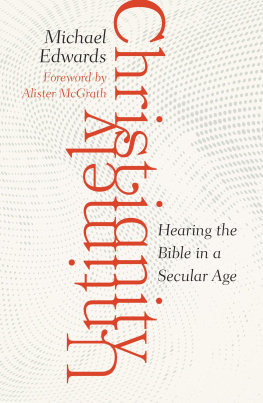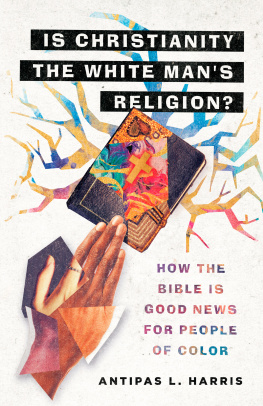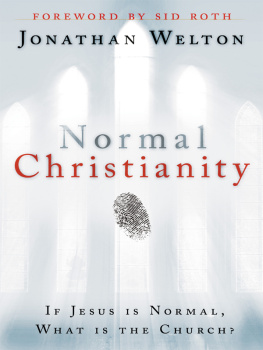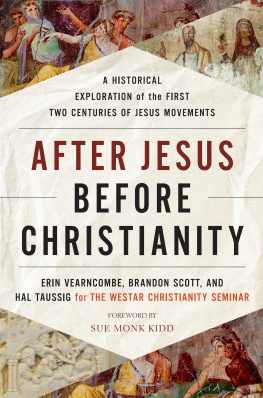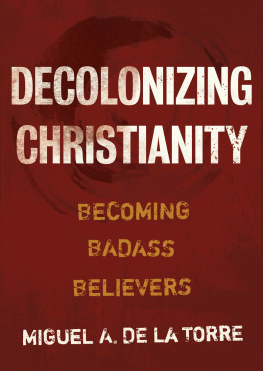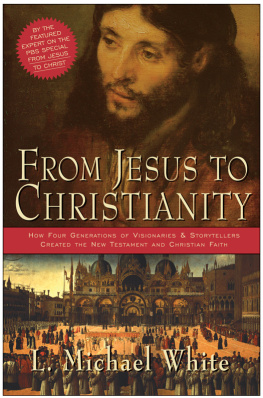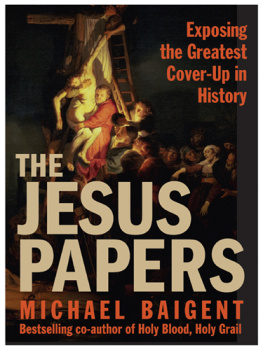L. Michael White - From Jesus to Christianity
Here you can read online L. Michael White - From Jesus to Christianity full text of the book (entire story) in english for free. Download pdf and epub, get meaning, cover and reviews about this ebook. year: 2016, publisher: HarperCollins, genre: Religion. Description of the work, (preface) as well as reviews are available. Best literature library LitArk.com created for fans of good reading and offers a wide selection of genres:
Romance novel
Science fiction
Adventure
Detective
Science
History
Home and family
Prose
Art
Politics
Computer
Non-fiction
Religion
Business
Children
Humor
Choose a favorite category and find really read worthwhile books. Enjoy immersion in the world of imagination, feel the emotions of the characters or learn something new for yourself, make an fascinating discovery.

- Book:From Jesus to Christianity
- Author:
- Publisher:HarperCollins
- Genre:
- Year:2016
- Rating:4 / 5
- Favourites:Add to favourites
- Your mark:
- 80
- 1
- 2
- 3
- 4
- 5
From Jesus to Christianity: summary, description and annotation
We offer to read an annotation, description, summary or preface (depends on what the author of the book "From Jesus to Christianity" wrote himself). If you haven't found the necessary information about the book — write in the comments, we will try to find it.
From Jesus to Christianity — read online for free the complete book (whole text) full work
Below is the text of the book, divided by pages. System saving the place of the last page read, allows you to conveniently read the book "From Jesus to Christianity" online for free, without having to search again every time where you left off. Put a bookmark, and you can go to the page where you finished reading at any time.
Font size:
Interval:
Bookmark:

To
Gwyn W. Shive
... for sharing the dream
and
Marilyn H. Mellowes
... for the story of the storytellers
CONTENTS
- Part One
The World of the New Testament - Part Two
The First Generation
Sectarian Beginnings - Part Three
The Second Generation
Birth Pangs and New Horizons - Part Four
The Third Generation
From Sect to Church - Part Five
The Fourth Generation
Coming of Age in the Roman World
Because this book is the product of many years of research and teaching, many people ought to be thanked, far more, in fact, than space permits. Those few I shall mention here have had a direct impact on the approaches and conclusions reached in this study, even when they might disagree with some of my conclusions.
I begin with those scholars whose work provided foundations for the scope and orientation of this book. A generation of Yale students will quickly recognize that much of this book reflects insights learned from Wayne Meeks both in seminars and in his own teaching. Others will just as quickly recognize Helmut Koesters influence in the geographical and archaeological orientation and in other key details. The result, I hope, is a heightened sense of the social and historical reality of the world out of which the Christian movement arose. As always, a guiding light in my work of examining the Greco-Roman world is my other mentor at Yale, Abe Malherbe.
I also wish to thank my colleagues: first, those with whom I worked so closely in organizing three Society of Biblical Literature research groups: The Social History of Formative Judaism and Christianity, The Archaeology of Religion in the Greco-Roman World, and Hellenistic Moral Philosophy and Early Christianity. Then there are those with whom I have been privileged to serve in the academic trenches, especially at Oberlin and The University of Texas at Austin. I have learned much from all of them and continue to be grateful for the abiding friendships.
Next, I thank my many students at Yale, Indiana, Oberlin, and now at UT Austin, both undergrads and grad students alike, who have been the sounding board in countless ways for these approaches and conclusions. Their questions helped me sharpen not only the what but also the why and how of presenting the history of formative Judaism and Christian origins. Fortunately, the learning never stops.
Finally, I wish to thank several people who have encouraged me to share this story with a broader audience, especially Dr. and Mrs. William Shive, along with their daughters, Dr. Kathy Matthews and Dr. Karen Browning; Rev. and Mrs. Ronald Nelson Smith; Marilyn H. Mellowes of WGBH Boston; David Fanning and Mike Sullivan of Frontline; and John Loudon of Harper San Francisco.
As always, I owe an enormous debt of gratitude for their love and support to my family: my parents, Lloyd and Pat White; my wife, Gloria; and my children, Jessica and Travis.
Austin, Texas
3 May 2004
Books tell stories. No, thats not quite true. People tell stories and write them down in books. Books record those stories and make them accessible to readers. In that sense they are a medium of communication to a broader audience. Communication is easier when author and audience come from a shared cultural background and time; then it is much like hearing the story told orally. Here the burden is on the storyteller to communicate in words and ideas that the audience will find meaningful.
But books also preserve stories and thus make it possible for later generations of readers to encounter not only a story of a bygone era but also the people who once told and heard it. Here the medium of communication is more complex. Now, the readernot the storytellerbears the burden. In order to understand the story, the reader must negotiate changes in culture, language, and ideas that come with the passage of time. It is a process of translation from one age to another, from one culture to another, in order to hear the story as once told. At this juncture there are two stories at work. The preservation and subsequent history of the book is its own story, apart from the one on its pages, and the reader must encounter this second storythe story of the bookas well. The reading of any story from the past must respect the different layers of history and story, of then and now, that make it up.
This book is the story of the origins and development of the Christian movement as told by the people who lived it. It took place roughly two thousand years ago and covers a span of several centuries. It comes out of the history of Israel and the Jewish people but intersects with the histories of Greece and Rome. The story, at least the best-known version of it, is preserved for us in the book known by Christians as the Bible, and more specifically in the second part, called the New Testament. There are other sources too, but they are not as well known; we shall bring them into the picture as they too begin to reflect the telling and retelling of the story.
Readers of the New Testament today may have a hard time thinking of it as an ancient work. It can be read in English and other languages, and there are numerous modern versions that try to make it more intelligible to a contemporary audience. But all of the New Testament was originally written in Greek, the popular form of Greek often called koine (meaning common) that was typical of the Hellenistic age. It was assembled over time, copied and recopied, and passed down through the centuries by Christians. In the Greek Orthodox tradition it remained in Byzantine Greek; in the Roman Catholic tradition it was rendered into Latin; and there were other translationsCoptic, Syriac, Ethiopic, Armenian, Slavonic. Translating the Bible into English came much later and, like German, only became widely used as a result of the Protestant Reformation.
When we encounter the New Testament in English, moreover, we may first perceive it as a single book that traces the story of Jesus, the founder of Christianity, and the lives of his first followers. It begins appropriately enough with the birth of Jesus and continues with his life and death, as reported in the Gospels. Next comes the story of the early church as recorded in Acts, followed by a number of letters written, it would seem, by the same cast of charactersPeter, John, Paulwho show up in the Gospels and Acts as Jesuss followers. On closer reading, however, we quickly realize that this is not just one story; there are in fact four different accounts of Jesuss lifethe Gospels of Matthew, Mark, Luke, and John. Nor is it just one book; the New Testament is a collection of books, and a collection of stories. It is more like a library, an ancient library that was intentionally assembled to preserve these stories by and for later generations of readers. Given the more complex and ancient character of its contents, how then shall we go about reading the New Testament?
First, because of its composite nature, it cannot be read like a novel, straight through from beginning to end. The various works represent different genres of literature: biographies, histories, novels, letters, sermons, apocalypses, catechisms, and church-order manuals. They were written at different times by different authors; consequently, there is no cohesive narrative. Even though they were all written in Greek, the language, tone, and style are noticeably different from one author to the next, just as in any library. Hence the various works within the collection must be read first on their own individual terms. Points of connection, comparison, and contrast come later, once we understand something of the origin of each work: where it was written, when, and why.
Font size:
Interval:
Bookmark:
Similar books «From Jesus to Christianity»
Look at similar books to From Jesus to Christianity. We have selected literature similar in name and meaning in the hope of providing readers with more options to find new, interesting, not yet read works.
Discussion, reviews of the book From Jesus to Christianity and just readers' own opinions. Leave your comments, write what you think about the work, its meaning or the main characters. Specify what exactly you liked and what you didn't like, and why you think so.

